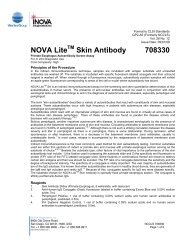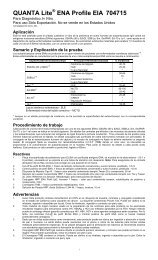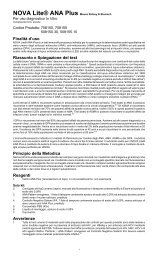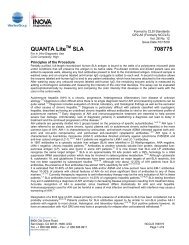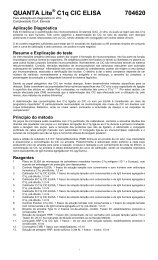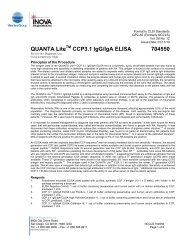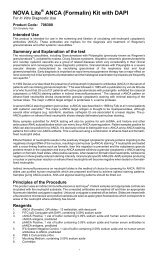QUANTA Lite ENA Profile EIA - inova
QUANTA Lite ENA Profile EIA - inova
QUANTA Lite ENA Profile EIA - inova
Create successful ePaper yourself
Turn your PDF publications into a flip-book with our unique Google optimized e-Paper software.
ProcedureMaterials provided• Instruction Leaflet: Giving full assay details.• QC Certificate: Indicating the expected performance of the batch.• <strong>ENA</strong> <strong>Profile</strong> Coated Wells: 12 x 8 well strips in which each of the wells is coated with purified <strong>ENA</strong> antigens asindicated in the table in Principles of the Procedure. Each plate is packaged in a re-sealable foil bag containingtwo desiccant pouches.Note: To ensure correct alignment of the rows, the strips can only fit the frame in oneorientation.• Type III Sample Diluent: 1 bottle containing 50mL of buffer for diluting the samples. Ready to use.• HRP Wash Concentrate: 1 bottle containing 25mL of a 40x concentrated buffer for washing the wells.• <strong>ENA</strong> <strong>Profile</strong> ELISA Cut-off: 1 bottle containing 1.6mL of diluted human serum. The expected <strong>ENA</strong> result isgiven on the QC certificate. Ready to use.• <strong>ENA</strong> <strong>Profile</strong> Positive Control: 1 bottle containing 1.6mL of diluted human serum. The expected <strong>ENA</strong> result isgiven on the QC certificate. Ready to use.• HRP <strong>ENA</strong> <strong>Profile</strong> IgG Conjugate: 1 bottle containing 10mL of peroxidase labelled antibody to human IgG.Coloured blue, ready to use.• TMB Chromogen: 1 bottle containing 10mL TMB substrate. Ready to use.• HRP Stop Solution: 1 bottle containing 10mL of 0.344M Sulfuric Acid. Ready to use.Additional materials required but not provided• Automatic microplate plate washer: This is recommended, however, plate washing can be performedmanually.• Plate reader: Capable of measuring optical densities at 450nm referenced on air.• Distilled or deionised water: This should be of the highest quality available.• Calibrated micropipettes: For dispensing 10-1000µL.• Multichannel pipette: Recommended for dispensing 100µL volumes of conjugate, substrate and stop solution.• Glass/plastic tubes: For sample dilution.MethodBefore you start1. Bring the kit to room temperature• The kit is designed for room temperature operation (20-24°C).• Remove the kit from storage and stand at room temperature for approximately 60 minutes. Wellsmust not be removed from the foil bag until they have reached room temperature.Note: The kits maybe maintained at room temperature for up to 1 week.2. Kit componentsGently mix each kit component before use.3. Wash buffer (40X concentrate) dilutionDilute the HRP Wash Concentrate 1:40 by adding the contents of the HRP Wash Concentrate bottle to975mL of distilled or deionized water. If the entire plate will not be run within this period, a smaller quantitycan be prepared by adding 2.0mL of the concentrate to 78mL of distilled or deionized water for every 16wells that will be used. The diluted buffer is stable for 1 week at 2-8°C. If the entire kit is not likely to beused within this time, smaller volumes can be made as appropriate. If the buffer shows any signs ofmicrobial contamination or turns cloudy, discard and prepare a fresh dilution.4. Strip and frame handlingRemembering that each patient sample to be tested requires a single micro-well strip, place the requirednumber of strips in the frame of the plate. Position from well A1, filling columns from left to right across theplate. When handling the plate, squeeze the long edges of the frame to prevent the wells falling out.Note: Return unused wells to the foil bag immediately with the two desiccant pouches and re-seal tightly tominimise exposure to moisture. Take care not to puncture or tear the foil bag, see below.WARNING:Exposure of wells to moisture or contamination by dust or other particulate matter will result inantigen degradation, leading to poor assay precision and potentially false results.5. Sample dilutionDilute 10µL of each sample with 1000µL of sample diluent (1:101) and mix well.Note: Diluted samples must be used within 8 hours.Note: The positive and cut-off controls are ready to use and require no dilution.Assay procedureMaintain the same dispensing sequence throughout the assay.1. Sample additionUsing one whole strip per test sample, dispense 100µL of the ready to use cut-off control into row A andpositive control into row B of all the strips. Add 100µL of diluted (1:101) test sample to the remaining 6 wellsin each of the strips. Note: Samples must be added to the plate as quickly as possible to minimise assaydrift, and the timer started after the addition of the last sample.Incubate at room temperature for 30minutes.2. WashingThe washing procedure is critical and requires special attention. An improperly washed plate will giveinaccurate results, with poor precision and high backgrounds. After incubation remove the plate and washwells 3 times with 200-300µL wash buffer per well. Wash the plate either by using an automatic platewasher or manually as indicated below. After the final automated wash, invert the plate and tap the wellsdry on absorbent paper.Plates can be washed manually as follows:3




